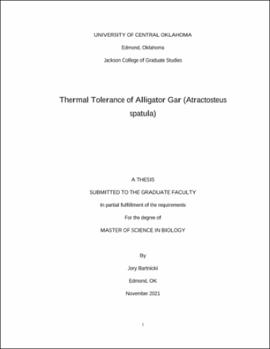| dc.description.abstract | Alligator gar belong to an ancient lineage that dates back over 215 million years. Historically, alligator gar populations occurred in the Mississippi River basin from Illinois (USA) to Mexico. Alligator gar populations have been reduced or extirpated throughout much of their range, and introductory programs have been implemented by some state and federal agencies attempting to reestablish historical populations. Efforts have been aided by studies investigating many ecological and life-history aspects of this species. However, thermal minima has yet to be evaluated for alligator gar. The goal of this thesis is to provide quantified estimates of alligator gar minima temperatures and to forecast potential range distribution based on current and predicted future climate scenarios. Newly hatched alligator gar were collected from a hatchery. The gar were acclimated to three different aquarium temperatures (21°C, 24.5°C, and 28°C) and then the water temperature was slowly decreased until the gar lost equilibrium. Variables (temperature[°C], total length [mm], and weight [g]) were tested for correlation and logistic regression models were used to determine the relationship between loss of equilibrium temperature and length or weight. Akaike’s information criterion scores were used to evaluate the best model. Additionally, alligator gar occurrence data was obtained from published papers, historical photos, field observations, and by downloading existence records from the Global Biodiversity Information Facility. These occurrences were combined with bioclimatic variables, terrestrial, aquatic and elevation data and then run in Maxent to estimate a current range and to forecast potential future ranges under different predicted climate scenarios. All variables were tested for correlation and Akaike’s information criterion scores in addition to receiver operating characteristics were used to evaluate models. Mean critical thermal minima temperatures obtained for each acclimation were 11.57°C, SD = 1.39 (21°C), 12.83°C, SD = 1.47 (24.5°C), and 14.16°C, SD = 1.60 (28°C). Alligator gar suitable habitat is expected to increase and shift to the north under all climate scenarios. The furthest shift north occurs under the most extreme warming scenario. This study provides the first quantified estimates of juvenile alligator gar thermal minima temperatures and fills a gap in alligator gar life history. The results from this study can be used in future studies aimed at conservation and management of alligator gar. Additionally, findings from this study can aid in determining the future northern extent of alligator gar distribution. Future research should investigate critical thermal minima of alligator gar larger than 519mm (the largest individual used in this study). Also, the survival of alligator gar that have been introduced at the northern edge of current projected suitable habitats should be followed to verify recruitment. | en_US |
